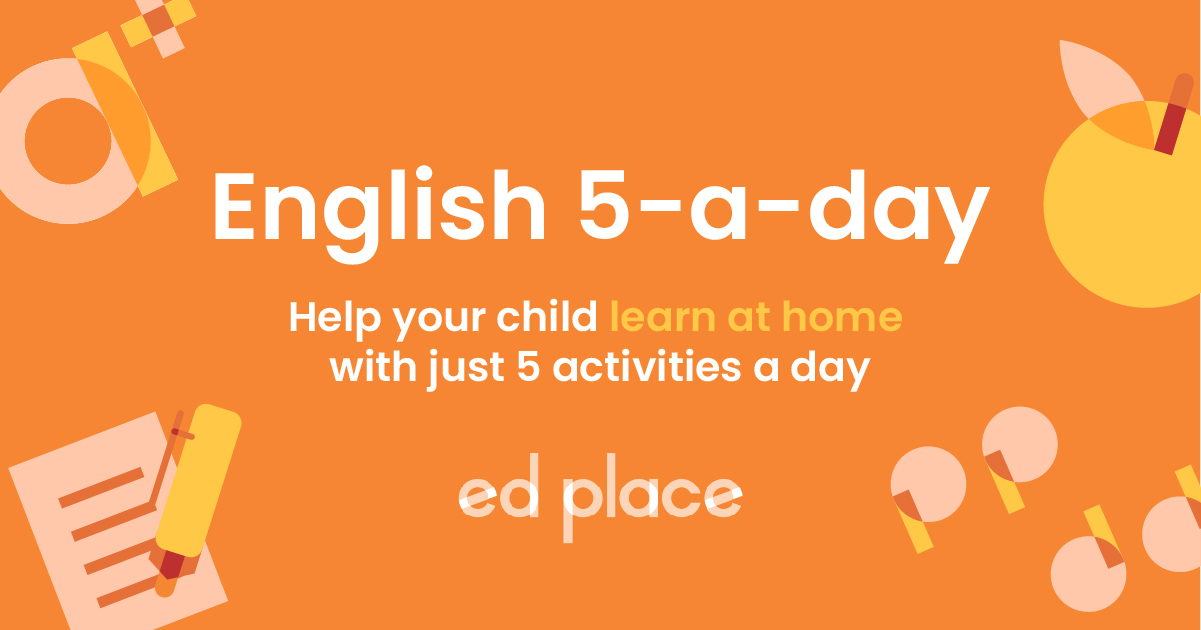
EdPlace's Year 4 Home Learning English Lesson: Fronted Adverbials and Commas
Looking for short lessons to keep your child engaged and learning? Our experienced team of teachers have created English, maths and science lessons for the home, so your child can learn no matter where they are. And, as all activities are self-marked, you really can encourage your child to be an independent learner. Get them started on the lesson below and then jump into our teacher-created activities to practice what they've learnt. We've recommended five to ensure they feel secure in their knowledge - 5-a-day helps keeps the learning loss at bay (or so we think!). Are they keen to start practising straight away? Head to the bottom of the page to find the activities.
Now...onto the lesson!
Afraid of fronted adverbials? Confused about commas?
The issue of adverbs can often be quite a problem for parents and children alike, and if you add the whole question of commas ....well, it’s a recipe for disaster!
Let’s take it all back to the beginning and work it through one step at a time to make it easier to understand. We’ll start by sorting out the confusion between adverbs and adjectives, get a firm grasp of what an adverb is, and therefore, the meaning of that scary term ‘fronted adverbial’. Finally, we’ll sort out the commas issue once and for all.
We’re confident that by the end of this guide your child will be able to:
1) Understand the difference between adjectives and adverbs
2) Recognise a fronted adverbial
3) Apply commas correctly following a fronted adverbial.
Step 1: Is it an adjective or an adverb?
These two word types cause a lot of confusion for many people - perhaps this is not surprising since they are both types of describing words. Adjectives describe a noun, giving us more detail about a person, a place or a thing.
For example, if we come face to face with a tiger, it would be helpful to know if it is a tame tiger or a fierce tiger, a hungry tiger or a sleepy tiger. All those highlighted words are adjectives.
An adverb, on the other hand, describes a variety of word types but usually gives us more detail about a verb. This is easy to remember since the word adverb actually includes the word verb!
So, using the same example of the tiger above: the tiger might be growling fiercely, or yawning sleepily, or sleeping deeply, or even running fast. All these highlighted words are adverbs.
Did you spot that most of the adverbs highlighted above ended in ‘ly’? Adverbs often do end in that suffix but not always; common adverbs that don’t end in ‘ly’ are ‘fast’, ‘often’, ‘well’, ‘always’, ‘later’ etc.
You may also have spotted that some of the adverbs are very similar to the adjectives. Indeed, there are a few words that can be used as both adjectives and adverbs, eg. Fast – you can have a fast car (adjective) or the car drove fast (adverb). If that is confusing, then look to see which word is being described as ‘fast’. In the first example, it is the car being described (so this is an adjective), but in the second, it is describing how the car is driven (making it an adverb).
Adjectives can often be changed into adverbs by adding the suffix ‘ly’, such as ‘greedy’ to ‘greedily’, ‘happy’ to ‘happily’, ‘cold’ to ‘coldly’ etc.
Step 2: Recognising adverbs
So, we know that an adverb usually describes a verb and often ends in ‘ly’. This is a good start!
When looking for an adverb, ask yourself the questions how, where, when or how often the verb is being done. The answer to this question is usually the adverb:
I will play football vigorously - how will I play football?
I will play football outside – where will I play football?
I will play football later – when will I play football?
I will play football every day – how often will I play football?
However, adverbs are versatile little words and can also be used to describe adjectives and even adverbs themselves! Look at the examples below in which the adjectives are coloured red and the adverbs are blue:
The snow was seriously deep.
I was extremely tired.
The cat was terribly scared.
He drove dangerously fast.
The children played incredibly nosily.
The band performed very well.
Step 3: So, what is a fronted adverbial and what is a comma?
Fronted adverbials
Now we know how to identify an adverb, it’s time to sort this out.
Firstly, an adverbial works the same way as an adverb by describing how, where, when or how often an action happens. In this case, however, it can be made up of more than one word or indeed an entire phrase. This means that the following are all examples of adverbials:
Of place (where): here, there, somewhere, outside, inside, near the house etc.
Of manner (how): greedily, quickly, nicely, carelessly etc.
Of time (when): now, then, later, tomorrow, soon, yesterday, still, now etc.
Of frequency (how often): rarely, frequently, seldom, every day, twice a week, again and again, usually etc.
So, what do we think a fronted adverbial could be? That’s right, you’ve guessed it – a fronted adverbial is simply an adverbial placed at the front or beginning of a sentence. It gives us information about the action to follow - how it happens, where, when or how frequently.
For example, a sentence might start with noisily or quietly, either of which tells us how the action takes place.
Or with outside, somewhere, or here, all of which tell us where the action happens.
Or with later, now, or still, which tell us when the action happens.
Or a sentence might start with frequently or now and then, either of which tells us how often the action takes place.
Some fronted adverbials can be a much longer phrase that includes nouns and adjectives as well as adverbs. It is still an adverbial phrase because it is describing the action of the sentence.
For example:
In the black water of the lagoon, the huge monster lay in wait. The highlighted words make up the fronted adverbial and they are describing where the action is taking place.
Much later that morning, Joe staggered out of bed. The fronted adverbial here is describing when the action occurred.
Commas
When a sentence starts with an adverbial, it is usual to follow it with a comma to separate it from the rest of the sentence and prepare the way for the action. When deciding whether or not to use a comma in our writing, the most important thing to consider is whether or not it makes it easier for the reader to understand what has been written.
Some fronted adverbials can be pretty long, as in the two examples given in Step 4, and it is obvious that a comma would make the sentence much easier to follow. Frequently, the fronted adverbial will consist of only one or two words, but they still need to be separated from the rest of the sentence as they act as a sort of gateway to the action.
Often, children get confused about commas.
Occasionally, my dog decides that he doesn’t want to have a walk.
From time to time, my internet connection becomes unstable.
Somewhere, there is a bag containing all my school books.
Greedily, my little brother gobbled up all the sweets.
If the sentence is very short, it might be possible to omit the comma, but always make sure that the meaning of the sentence is still clear.
For example, in the sentence ‘Later I went to bed’, it might be possible to do without the comma, but consider the difference that the comma might make. If we include a comma, it emphasises the lateness, so we might still choose to include it: ‘Later, I went to bed.’
If in doubt at this stage, the comma should be included after all fronted adverbials.
Step 4: Put it into practice...
Now it's over to you! First of all, (spot the fronted adverbial!) see if you can identify the adverbials in the sentences below and whether they are adverbials of manner (how), place, time or frequency:
1) The beach was incredibly busy with hundreds of tourists.
2. I like to go climbing several times a year.
3. Last weekend, we visited my grandparents.
4. My best friend lives somewhere over there.
Where would you put the commas in these sentences to separate the fronted adverbials?
5. Frequently my mum has to tidy my bedroom.
6. At least twice a year we get a visit from my cousins.
7. Later we will catch the bus to school.
8. Hurriedly I stuffed my books into my bag.
9. On top of the highest mountain he made a promise to his friend.
10. Underneath my unmade bed a huge spider lurks.
Step 5: Activity Time!
Hopefully, your child is feeling more confident about tackling fronted adverbials and commas. Once you have gone through all of these with your child and they are feeling confident, get them to have a go at the activities below to practise their skills.
All activities are created by teachers and automatically marked. Plus, with an EdPlace subscription, we can automatically progress your child at a level that's right for them. Sending you progress reports along the way so you can track and measure progress, together - brilliant!
Activity 1 - Identify Adverbs in a Sentence 1
Activity 2 - Identify Adverbs in a Sentence 2
Activity 3 - Identify Adverbs in a Sentence 3
Activity 4 - Grammatical Boundaries: Using Commas in Sentences
Activity 5 - Sentence Structure: Commas and Subordinate Clauses 1
Answers:
1) incredibly, manner
2) several times a year, frequency
3) last weekend, time
4) somewhere over there, place
5) Frequently, my mum has to tidy my bedroom.
6) At least twice a year, we get a visit from my cousins.
7) Later, we will catch the bus to school.
8) Hurriedly, I stuffed my books into my bag.
9) On top of the highest mountain, he made a promise to his friend.
10) Underneath my unmade bed, a huge spider lurks.
Keep going! Looking for more activities, different subjects or year groups?
Click the button below to view the EdPlace English, maths, science and 11+ activity library
All English, maths and science from Year 1 - GCSE








